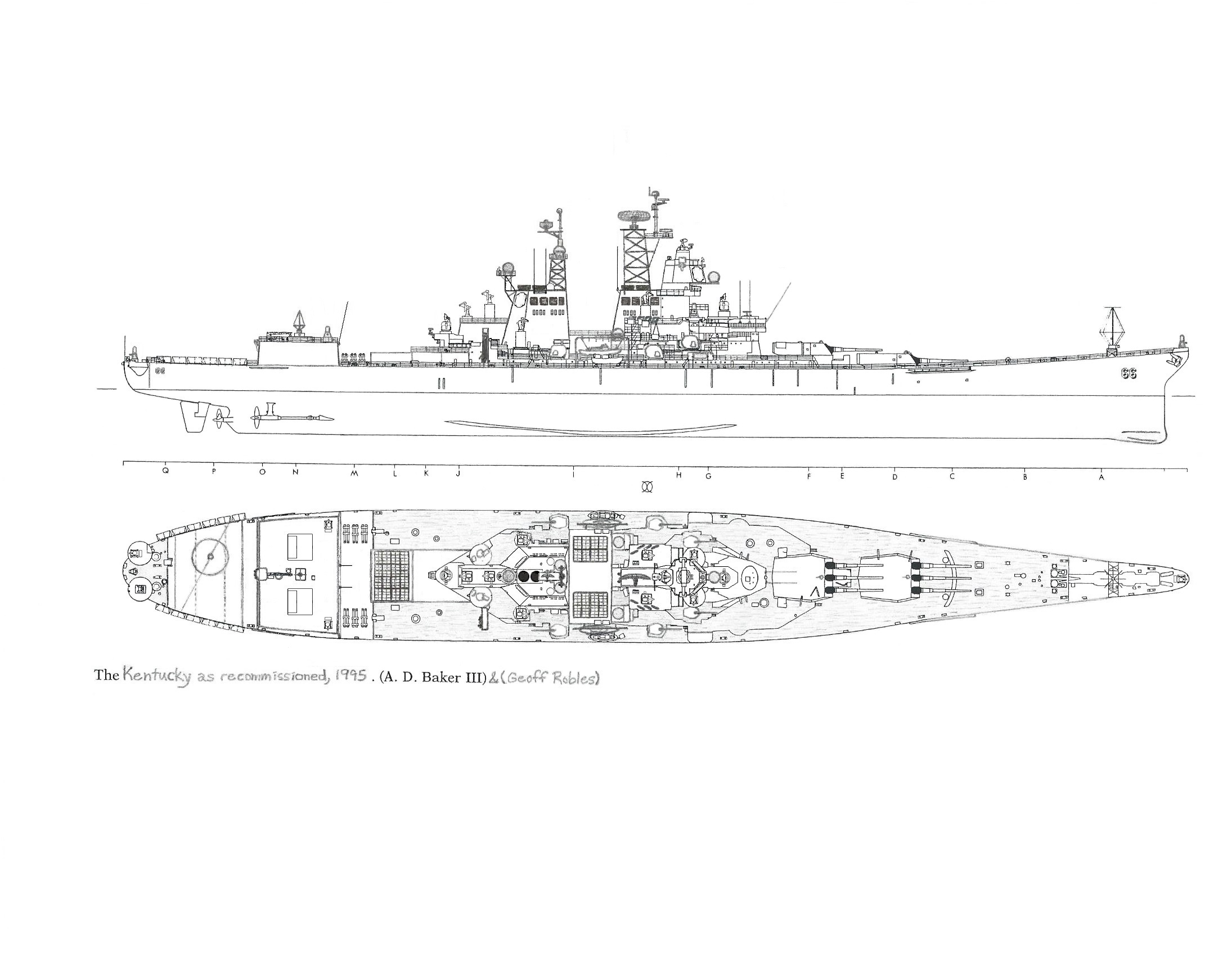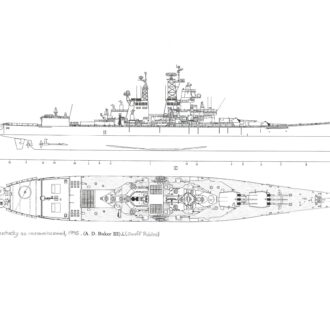


This is my final version of the USS Kentucky, depicted as a modern Guided Missile Battleship. I decided to go back to the the well as it was for this one. I was never quite happy with how any of the 1995 versions of this ship turned out. So, I finally went (literally) back to the drawing board. This time I added AEGIS to control the ship’s AAW missiles. I also decided to completely replace the stacks with ones that made it more clear that the ship now has Gas Turbines instead of Steam Turbines. I also decided to add a proper enclosed hanger for the ship’s helicopters along with storage sheds for the ship’s Pioneer Reconnaissance Drones. The ship would now use Mk41 VLS launchers for all AAW, ASW, & ASuW missiles (except for the Harpoon Missiles which would still use deck mounted quad cannister launchers). Finally, I decided to restore the ship’s original hull number. While she’d still be classified as a Guided Missile Battleship (BBG), she’d revert back to using the regular battleship hull number sequence. At the time of her recommissioning, she (along with her sister, the Illinois) would be the largest, most powerful, and somewhat ironically, the most technologically advanced Surface Combatant in the World.
As for the ship itself, there was a ‘real’ battleship Kentucky. It was never completed and eventually scrapped while still half built. There were proposals to make her a guided missile ship, but obviously they were never acted on. This drawing represents my vision of how she could have appeared in the Nineties with AEGIS and VLS as a unit of a notional Illinois Class (named after her aforementioned sister ship that also wasn’t completed). While she has essentially the same dimensions as an Iowa class Battleship (both she and the Illinois were to be units of that class) there are enough differences for her and her sister to be considered a completely different class.
Overall, the armor of this ship (and her sister, the Illinois) would differ in many ways from an Iowa class battleship. The hill would also be a bit different as well. Since this ship is part of an “alternate timeline” concept, I figured “why not go all the way”? I decided to go all the way to when this ship was still on the drawing board and starting altering things right from the start. Obviously, I could only change details of the design, but those details can make quite a difference. The Illinois and Kentucky were actually a redesign of the Iowa class anyways so making additional changes wouldn’t be unreasonable. The structural design of the torpedo protection system was revised and the overall structural design was revised so the ships could be of entirely welded construction as opposed to a combination of riveted and welded construction. I decided to go even further than that with both the hull design and details of the armor protection. I somewhat reshaped the hull forward, streamlining it a bit to eliminate the hard shoulder the Iowas have just forward of their Number 1 Gun Turrets. I’m hoping this would help both seakeeping and hydrodynamic efficiency.
The armor would be an evolution of the Missouri’s and Wisconsin’s (which had their forward armor bulkheads and the fronts of the forward barbettes thickened) armor scheme. The main armor deck would see the most significant changes. It would go from 4.75” on a 1.25” backing plate (with 5” on 1.25” above the torpedo protection system), to 5” on a 1” backing plate (with 5.3” on 1” above the torpedo protection system). The turret faceplates would go from 17” on a 2.5” backplate, to 18” on a 1.5” backplate. The conning tower and the sides of the barbettes would be thickened by 0.2” from 17.3” to 17.5”. As a weight compensation, the turret and conning tower roofs would be reduced in thickness by 0.5”, from 7.25” to 6.75”. I always felt the armor on the roofs of the conning tower and the turrets was excessive, especially in comparison to the rest of the armored citadel. Reducing them to be more in line with the outboard sections of the decks bought the weight needed to beef up the conning tower and barbettes. I also felt the backing plates for the main armor deck were excessively thick and by thinning them, I could thicken the plates above them with no increase in weight.
In addition to replacing the Mk10 Terrier Missile launcher with a Mk41 VLS launcher, the 5” Secondary Battery has been replaced as well. The twin 5”/38cal Mk28 mounts have been replaced by modern single Mk45 5”/54cal mounts. Now these are a bit different than other Mk45s in that they feature 2.5” HY80 gun shields in place of the normal 1/2” thick ones. For this reason they’re designated as the Mk45mod2(b). As the thicker gun shield is really the only difference from other Mk45mod2 guns, a separate model designation is unwarranted and thus just receive a “(b)” sub-designation (plus I just didn’t want to mess around with the designations of the Mk45 variants and create confusion there).
The deckhouse structure attached to the aft superstructure replaces the Number 3 Turret. It is heavily armored to largely simulate the weight of the removed turret and barbette. It would have originally served a Mk10 Terrier Missile Launcher when the ship was originally completed. The Mk10 launcher has been landed along with the structure it sat upon and the roof of the deckhouse removed with the installation of what amounts to a tandem merged Mk41 launcher. This launcher has 122 cells for missiles, with 6 more cells taken up by replenishment cranes.
As suggested by the new stacks, the Steam Turbines (and their associated Boilers) along with the Steam Turbo-Generators have been completely replaced here. She would now use Gas Turbines for both propulsion and electrical power generation. Due to the new propulsion and power systems weighing far less than the previous systems, significant changes would be made in the Engineering spaces. The new engines would have heavily reinforced and insulated foundations to reduce vibration, noise, and protect the engines from shock damage. This ship would be nearly as quiet as a Spruance or Arleigh Burke at cruising speeds.
The innermost bottom structure of the ship would also be heavily reinforced with an additional layer of steel plate with a layer of sound insulation atop that and then yet another layer of steel. The holding bulkheads of the side protection system would also be heavily reinforced along with all of the transverse bulkheads in the Engineering spaces. These measures would serve two purposes. The first would be to improve the ship’s longitudinal strength allowing it to better withstand underbottom explosions. The second, would be to add over 1,500 tons of additional structure to compensate for how much lighter the ship’s new propulsion and electrical plant is.
The fire controls would also be updated with most of their analog components replaced with solid state digital computers. The fire control radars themselves would be similarly upgraded, with the Mk13 radar on the Main Battery Director (Mk38) being replaced with a new, all digital PESA AN/SPQ-13 radar (Which is basically the one fictitious component of the ship. It is essentially an enlarged and somewhat modified AN/APQ-164 radar from a B-1B Lancer) . The Secondary Battery Directors (Mk37s) on the other hand would be replaced outright by somewhat newer Directors (Mk68s) mounting AN/SPG-53F radars. However, only the fore and aft directors would be replaced, with the two waist Directors eliminated. All of these systems would be integrated into two Mk 34 Gun Weapon Systems (GWS), with one supporting the 16” (406mm) guns, and the other supporting the 5” (127mm) guns. These systems would allow for data linking with other platforms to obtain telemetry for plotting firing solutions (as well as providing telemetry and targeting data for friendly ships and aircraft).
All of these combat systems would be controlled from a large CIC that would be located in former engineering spaces. This ship would also be extensively outfitted and equipped to serve as a Fleet Flagship. It would be equipped with a Tactical Flag Command Center (TFCC), along with Intelligence and Communication spaces that would allow this ship to serve quite effectively in this role. Some of these spaces would also occupy engineering spaces freed up by the conversion to Gas Turbines. Finally, I should note that the Conning Tower depicted here is the three-story Force Flagship version.
Specifications (for 1995 recommissioning):
Length: Waterline: 860′ (262.13meters), Overall: 887′ (270.35meters)
Beam: 108’2″ (32.97meters)
Draft: 35’5” (10.8meters) [not including sonar dome]
Displacement: (full load) 55,800 tons
Power Plant:
Propulsion: 8x General Electric LM2500 Gas Turbines (26,250 bhp each; 210,000 bhp total), coupled to 4 Shafts, driving either 5-bladed (inner shafts) or 4-bladed (outer shafts) reversible controllable-pitch propellers
Electrical: 6x Rolls-Royce AG9140 AC Gas Turbine Generators (3,000 kW, 450V each; 18,000 kW total), 2x 400-cycle 2,000 kW Emergency Diesel Generators
Maximum Speed: 32.5 knots
Crew Complement: 1,020 Officers and Enlisted Personnel (Standard), 1,050-1,080 Officers and Enlisted Personnel (when serving as a Flagship/Command ship)
Armament:
6 (2×3) Mk7 16″ (406mm) 50cal guns
6 (6×1) Mk45mod2(b) 5″ (127mm) 54cal guns
3 MK 41 VLS Launchers (1×122 + 2×61) with a standard loadout of: 112 SM-2 (RIM-66M) Standard Missiles, 20 RUM-139 ASROC ASW Missiles, 112 BGM-109 Tomahawk Cruise Missiles
6 (6×4) Mk141 launchers (24 RGM-84 Harpoon Missiles)
2 (triple tube) Mk32 torpedo launchers (each launcher holds 3 Mk46mod5 NEARTIP torpedoes)
6 (6×1) Mk15 Vulcan Phalanx 20mm CIWS
4 (4×1) .50cal machine guns
4 (4×1) 7.62mm machine guns
Sensors:
Sonar: AN/SQQ-89 ASW Combat System (AN/SQS-53C Bow Sonar, AN/SQR-19 Towed Sonar, & AN/SQQ-28 LAMPS III Shipboard System)
Air Search: AN/SPY-1D PESA 3D S-Band Radars, AN/SPS-49(v)5 L-Band radar, AN/SPN-43 S-Band Air Traffic Radar
Surface Search: SPS-67(v)3 C-Band Radar, AN/SPS-64(v)9 X-Band Navigation Radar
Fire Control/Targeting: AN/SPQ-13 (replaces Mk13) X-Band Radar, 6 (6×1) AN/SPG-62 I-J-Band Radars, 2 (2×1) AN/SPG-53F X-Band Radars, Mk23 TAS, 2 (2×1) Mk46 Optical Sight Systems, Mk38mod5 Gunfire Director, 2 (2×1) Mk68 Gunfire Directors
Electronic Warfare and Countermeasures:
AN/SLQ-32(v)3 Electronic Warfare Suite
AN/SLQ-25A Nixie Acoustic Torpedo Decoy System
Mk36mod8 SRBOC Chaff System
Aircraft:
4 SH-60B Seahawk Helicopters (housed in two tandem hangars)
2 RQ-2 Pioneer Reconnaissance UAVs (housed in two sheds atop the Hanger)


Leave a Reply